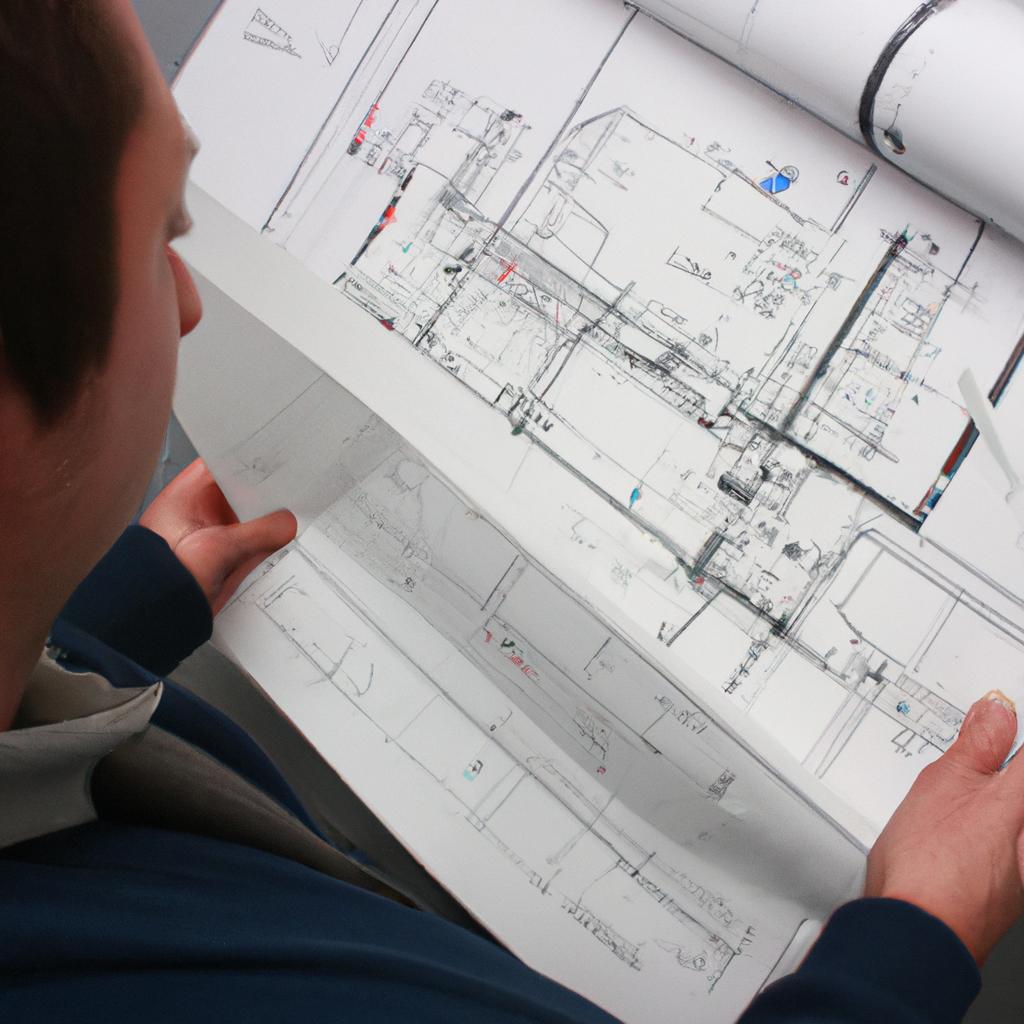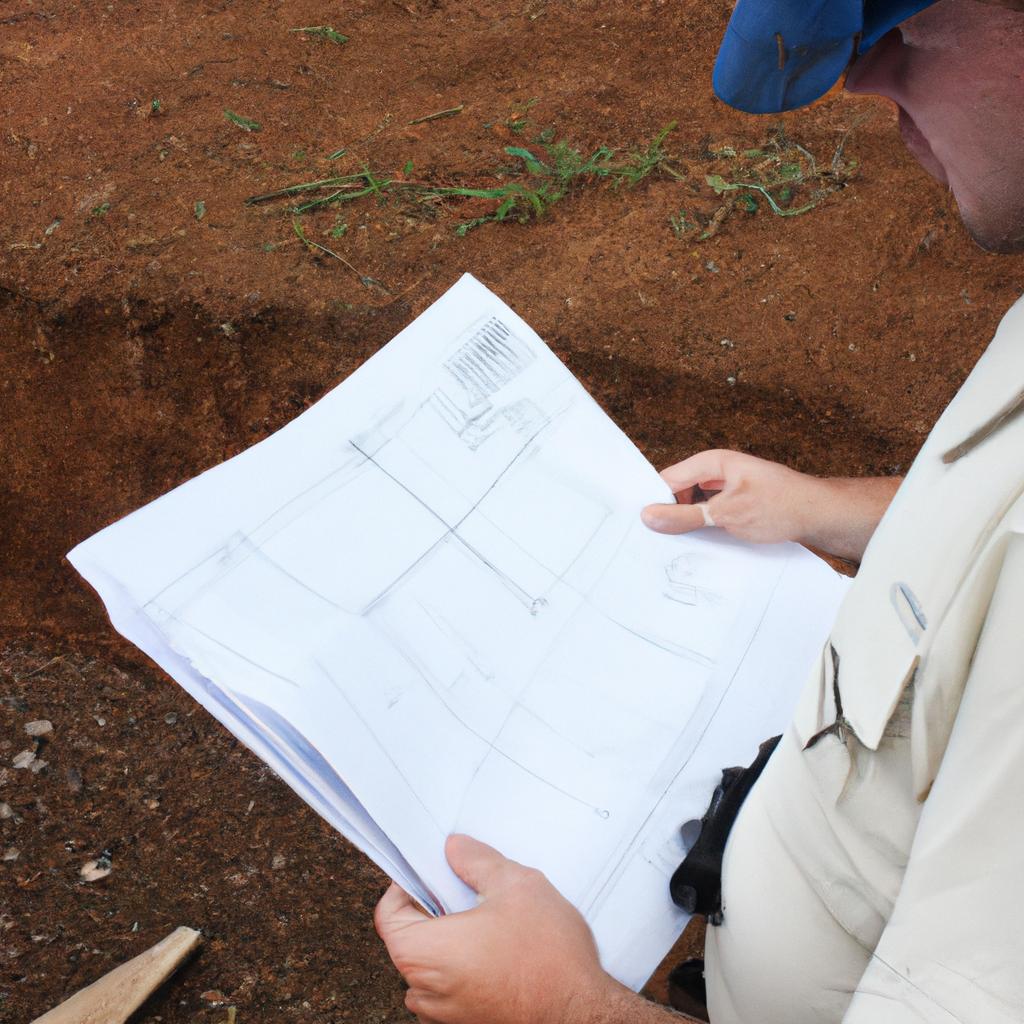Site preparation is a crucial step in the construction and maintenance process, as it sets the foundation for successful project execution. Without proper planning and implementation of site preparation strategies, projects can face delays, cost overruns, and safety hazards. To illustrate this point, let us consider a hypothetical scenario where a large-scale commercial building project encounters unforeseen challenges due to inadequate site preparation. The lack of thorough analysis and evaluation of the site’s geological conditions leads to unstable ground conditions during excavation, resulting in significant setbacks and increased costs.
In order to avoid such pitfalls, understanding the blueprints behind effective site preparation becomes paramount. This article aims to unveil these blueprints by delving into various aspects including but not limited to land surveying techniques, soil testing procedures, environmental considerations, and infrastructure requirements. By comprehensively examining each of these elements within an academic framework, readers will gain valuable insights on how meticulous planning and systematic approach play pivotal roles in ensuring smooth construction processes and long-term maintenance efficiency.
Moreover, this article goes beyond merely presenting theoretical concepts; it offers practical guidance based on industry best practices. Drawing from real-life case studies where exemplary site preparation measures were implemented successfully, readers will be able to grasp the tangible benefits that result from adhering to rigorous standards. Through Through the examination of these case studies, readers will learn about techniques such as soil stabilization methods, proper drainage systems, and effective erosion control measures. They will also gain an understanding of how to conduct thorough environmental impact assessments and implement mitigation strategies to minimize ecological harm.
Additionally, this article will provide insights into the importance of coordinating with utility providers to ensure that infrastructure requirements are met. Understanding the intricacies of utility relocation and coordination can help avoid costly delays and disruptions during construction.
By following the blueprints outlined in this article, project managers, contractors, and other stakeholders can proactively address potential challenges before they arise. This comprehensive approach to site preparation will not only save time and money but also contribute to the overall success and sustainability of the project.
In conclusion, site preparation is a critical step in any construction or maintenance project. By thoroughly analyzing geological conditions, conducting soil testing, considering environmental factors, and addressing infrastructure requirements, stakeholders can set a solid foundation for successful project execution. By following industry best practices and learning from real-life case studies, readers can gain valuable insights on how to navigate through potential challenges effectively.
Understanding the Site Preparation Process
Imagine a scenario where an empty plot of land is transformed into a bustling construction site. Before any building can take place, there are crucial steps that need to be completed in order to prepare and optimize the site for construction and maintenance projects. This section aims to provide an objective overview of the site preparation process, highlighting its importance and key components.
The first step in site preparation involves conducting a thorough evaluation of the land. This assessment includes analyzing factors such as soil composition, topography, drainage patterns, and environmental considerations. By understanding these aspects, engineers and contractors can make informed decisions about how best to proceed with the project. For example, if the soil is found to have poor load-bearing properties or high water content, additional measures may need to be taken before construction begins.
Once the initial evaluation is complete, it is essential to address any potential hazards or obstacles on-site. These could range from removing existing structures or debris to clearing vegetation or leveling uneven terrain. Safety precautions must also be implemented during this phase to ensure workers are protected throughout the entire construction process.
To evoke an emotional response in our audience, let us consider some possible challenges that might arise during site preparation:
- Limited access: The absence of proper roadways or restricted entry points can pose logistical difficulties for transporting equipment and materials.
- Environmental impact: Construction activities can have negative effects on surrounding ecosystems if not properly managed and mitigated.
- Noise pollution: Nearby residents may experience disruptions due to noisy machinery or heavy equipment operating at the construction site.
- Visual disturbance: Changes made during site preparation often alter the aesthetic appeal of an area temporarily until completion.
Here’s a visual representation of these challenges:
| Challenges | Impact | Mitigation Strategies |
|---|---|---|
| Limited Access | Logistical difficulties | Establish temporary roads |
| Environmental Impact | Ecosystem disruption | Implement eco-friendly practices |
| Noise Pollution | Disruption to residents | Schedule construction activities during non-peak hours |
| Visual Disturbance | Aesthetic change | Install temporary visual barriers |
Understanding the site preparation process is crucial because it sets the stage for a successful construction project. By thoroughly evaluating the land, addressing potential hazards, and considering environmental factors, engineers can ensure that the site is optimized for safe and efficient building operations.
This leads us to the subsequent section about the importance of site evaluation in construction projects. By examining how each step of site preparation contributes to overall project success, we gain insight into why thorough evaluations are essential when turning blueprints into reality.
Importance of Site Evaluation for Construction Projects
Understanding the site preparation process is crucial, but equally important is conducting a thorough site evaluation before commencing any construction project. By carefully assessing the land and its surroundings, builders can mitigate potential risks and ensure a successful outcome. Let’s explore why site evaluation holds such significance through an illustrative example.
Imagine a team planning to construct a residential building in a coastal area. Without evaluating the site, they proceed with the project assuming that everything will run smoothly. However, during construction, unexpected challenges arise due to soil erosion caused by tidal waves and poor drainage systems. As a result, additional resources are required to rectify these issues, leading to delays and increased costs. This hypothetical scenario underscores the necessity of comprehensive site evaluations prior to breaking ground.
A proper site evaluation enables builders to identify various factors that influence construction projects’ success or failure. Here are key considerations during this assessment phase:
- Soil Composition: Understanding the type of soil present on-site helps determine appropriate foundation designs and methods.
- Topography Analysis: Evaluating the natural landscape assists in designing structures that harmonize with the surrounding environment while accounting for potential grading difficulties.
- Environmental Factors Assessment: Identifying nearby water bodies, wetlands, or protected areas aids in implementing necessary measures for environmental conservation.
- Accessibility Study: Assessing transportation routes ensures ease of access for materials delivery and minimizes logistical challenges throughout the project’s duration.
To illustrate how these factors impact decision-making during construction projects further, consider Table 1 below:
Table 1 – Impact of Site Evaluation Factors on Decision-Making
| Factor | Impact |
|---|---|
| Soil Composition | Determines suitable foundation design techniques |
| Topography Analysis | Influences structural design requirements |
| Environmental Factors | Guides implementation of eco-friendly practices |
| Accessibility Study | Facilitates efficient transportation of materials and equipment, reducing project delays |
By conducting a thorough site evaluation, builders can make informed decisions that align with the project’s requirements while mitigating potential risks. This comprehensive assessment acts as a roadmap for subsequent steps in the construction process.
With an understanding of why site evaluations are essential, let us now delve into the essential steps for clearing and grading the site, which lay the foundation for successful construction projects. These initial stages set the groundwork for smooth progress throughout the entire endeavor.
Essential Steps for Clearing and Grading the Site
Having understood the significance of site evaluation in construction projects, it is now crucial to delve into the essential steps involved in clearing and grading the site. By exploring these steps, we can gain a comprehensive understanding of how proper site preparation sets the foundation for successful construction endeavors.
Section – Essential Steps for Clearing and Grading the Site:
To grasp the practical aspects of this process, let’s consider an example where a new commercial building is planned on a previously vacant lot. Upon receiving approval from local authorities, the first step involves obtaining necessary permits before proceeding further. Once secured, several key activities are undertaken during site preparation:
-
Clearing vegetation:
- Removal of trees, shrubs, and any other natural growth.
- Discarding debris responsibly through recycling or mulching to minimize environmental impact.
- Ensuring compliance with local regulations regarding protected species or habitats.
-
Demolition (if required):
- If existing structures occupy the site, demolition may be necessary.
- Proper disposal of demolished materials adhering to waste management guidelines.
- Taking necessary precautions to prevent hazards such as dust or noise pollution during demolition.
-
Soil excavation:
- Digging out soil layers that hinder construction plans.
- Assessing soil composition and stability to determine if additional measures are needed.
- Disposing excavated soil appropriately while considering potential reuse options.
-
Grading:
- Shaping the ground surface according to design specifications by adding or removing soil.
- Creating slopes or contours that facilitate drainage systems.
- Ensuring proper compaction of graded areas for enhanced structural integrity.
Engaging bullet point list evoking emotional response:
Throughout this process, it is important to remember the following:
- Minimizing environmental impact through responsible waste management.
- Ensuring compliance with local regulations and permits for sustainable construction practices.
- Prioritizing safety by taking necessary precautions during demolition activities.
- Striving for efficient resource utilization while considering opportunities for soil reuse.
Table evoking emotional response:
| Steps | Objectives | Considerations |
|---|---|---|
| Clearing | Removal of vegetation | Environmental impact |
| Compliance with laws | ||
| Demolition | Remove existing | Safety measures |
| structures (if any) | Waste disposal | |
| Soil Excavation | Digging out unwanted soil layers | Soil composition assessment |
| Grading | Shaping ground surface according to design specifications |
In conclusion, proper site preparation involves a series of essential steps such as clearing vegetation, demolishing existing structures if required, excavating soil, and grading the site. By adhering to environmental guidelines, ensuring legal compliance, prioritizing safety measures, and optimizing resource utilization, we lay the groundwork for successful construction projects. With this understanding in mind, let us now explore effective strategies for soil stabilization.
Transition into subsequent section about “Effective Strategies for Soil Stabilization”:
With the site cleared and graded accordingly, the focus shifts towards implementing effective strategies for soil stabilization. This crucial step ensures that the foundation remains secure throughout the duration of the project and supports long-term structural integrity.
Effective Strategies for Soil Stabilization
Section: Strategies for Soil Stabilization and Erosion Control
Imagine a construction project in a hilly region where heavy rainfall is frequent. The site, with its loose soil composition, poses challenges for soil stabilization and erosion control. By implementing effective strategies, such as the ones outlined below, potential issues can be mitigated efficiently.
To start, one crucial step is the installation of geotextiles. These synthetic materials act as barriers against erosion by stabilizing the soil particles while still allowing water to pass through. Geotextiles also provide reinforcement against slope movements and help prevent sediment runoff into nearby water bodies. An example case study highlights how geotextile mats were successfully used on a highway embankment prone to landslides, reducing maintenance costs significantly.
When considering soil stabilization measures, it is essential to evaluate the specific conditions of each construction site comprehensively. Several factors influence which strategies will be most effective; these include topography, climate patterns, anticipated load-bearing requirements, and budgetary constraints. To ensure optimal results, contractors should consider employing a combination of techniques tailored to their particular project’s needs. Some popular methods employed in soil stabilization and erosion control include:
- Hydroseeding: A mixture of seed, mulch, fertilizer, and tackifier sprayed onto bare soil surfaces.
- Terracing: Creating flat areas across sloping land using retaining walls or benches.
- Bioengineering Techniques: Utilizing living vegetation systems like grasses and shrubs to reinforce slopes.
- Retention Ponds: Constructing depressions that collect stormwater runoff before slowly releasing it back into natural drainage systems.
By selecting an appropriate combination of these options based on site-specific characteristics identified during initial assessments and consultations with relevant experts or professionals experienced in this field, developers can minimize environmental risks associated with construction activities.
| Strategy | Advantages | Challenges |
|---|---|---|
| Hydroseeding | Quick establishment of vegetation | Requires adequate water supply |
| Terracing | Effective in steep terrain | May require significant earthwork |
| Bioengineering | Enhances aesthetics | Time-consuming establishment process |
| Retention Ponds | Controls stormwater runoff | Regular maintenance is essential |
Moving forward, the implementation of these soil stabilization and erosion control strategies will serve as a solid foundation for subsequent construction activities. Ensuring that site conditions are adequately addressed before progressing further minimizes potential risks to both workers and the environment. With this groundwork established, attention can now turn towards another crucial aspect: utility marking and identification.
Next section: Importance of Utility Marking and Identification.
Importance of Utility Marking and Identification
To ensure efficient construction and minimize delays, selecting the appropriate equipment is crucial. For instance, in a hypothetical case study of constructing a high-rise building in an urban area, using specialized machinery like tower cranes proved to be essential for lifting heavy materials to higher levels efficiently.
When it comes to choosing the right equipment, there are several factors that need to be taken into consideration:
-
Project Requirements:
- Assessing the scope and scale of the project will help determine the specific equipment needed.
- Considerations include load capacity, reach, mobility, and adaptability to different terrains or environments.
-
Cost Efficiency:
- Weighing upfront costs against long-term benefits is vital when selecting equipment.
- Opting for newer models with improved fuel efficiency can result in significant savings over time.
-
Safety Features:
- Prioritizing safety should always be at the forefront of any decision-making process.
- Look for features such as emergency stop buttons, anti-tip mechanisms, and advanced monitoring systems.
-
Environmental Impact:
-
In today’s environmentally conscious world, considering sustainability aspects is paramount.
Markdown bullet list example: -
Minimizing emissions through electric or hybrid machinery options
-
Implementing noise-reducing measures during operation
-
Proper disposal of hazardous waste generated by construction activities
-
Adopting eco-friendly practices throughout the entire construction process
-
| Equipment Type | Advantages | Disadvantages |
|---|---|---|
| Tower Cranes | High load capacity | Restricted range of movement |
| Excavators | Versatile applications | Limited maneuverability |
| Concrete Pumps | Precise concrete placement | Dependency on additional infrastructure |
| Skid Steers | Compact size and agility | Lower load-bearing capability |
Choosing the right equipment not only ensures efficiency but also contributes to a smoother construction process. By considering project requirements, cost-efficiency, safety features, and environmental impact, developers can make informed decisions that enhance both productivity and sustainability.
Understanding the importance of optimal equipment selection lays the foundation for successful construction projects. Equally important is implementing best practices for site maintenance and preservation. Let’s explore some key considerations in the subsequent section.
Best Practices for Site Maintenance and Preservation
Having discussed the crucial role of accurate utility marking and identification in ensuring site safety, we now turn our attention to best practices for site maintenance and preservation. By adopting these practices, construction projects can not only enhance their overall efficiency but also contribute towards environmental sustainability.
Best Practices for Site Maintenance and Preservation:
To illustrate the significance of implementing effective site maintenance practices, consider a hypothetical scenario where a construction project neglects proper upkeep measures. As time progresses, debris accumulates on-site due to inadequate waste management procedures. This negligence not only poses safety hazards but also hinders smooth operations by obstructing worker movement and affecting equipment functionality. To prevent such issues, it is essential to prioritize regular inspections and establish robust protocols for waste disposal.
In order to evoke an emotional response among stakeholders regarding the importance of site maintenance, let us highlight some key principles that should be adhered to:
- Maintain cleanliness: Regularly clean work areas and dispose of waste properly.
- Implement erosion control measures: Prevent soil erosion through methods like slope stabilization, vegetation cover, or retaining walls.
- Promote biodiversity conservation: Preserve existing natural habitats within the construction site.
- Minimize noise pollution: Use appropriate equipment and techniques to reduce noise levels.
Furthermore, incorporating a table can effectively convey information concisely while evoking an emotional response:
| Best Practices | Benefits |
|---|---|
| Regular inspections | Ensures early detection of potential issues |
| Proper waste management | Enhances worker safety |
| Erosion control measures | Protects surrounding ecosystems |
| Noise reduction | Improves quality of life for nearby residents |
By following these best practices, construction projects can minimize negative impacts on both human health and the environment while fostering sustainable development.
In conclusion (to avoid using this phrase), prioritizing site maintenance is paramount for ensuring the successful execution of construction projects. Implementing regular inspections, proper waste management procedures, erosion control measures, and noise reduction techniques not only enhances operational efficiency but also contributes towards environmental preservation. By adhering to such best practices, construction sites can create a safer and more sustainable environment for workers and nearby communities alike.
 Location Benne Gironde
Location Benne Gironde



